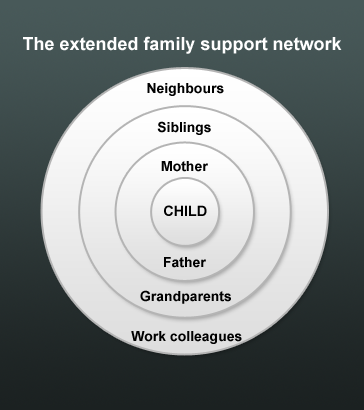
In the 21st century, extended families are far more the day-to-day reality
for children than 'just' parents. Parents are an integral part of families,
but key as they are to every child, the modern reality is that many children
find other family members undertake a significant care-giving role.
Consequently, it is important that schools shift the focus from talking
only of 'Partnership with Parents' to 'Partnership with Families', that
wider group of supporters who are involved in the cycle of upbringing.
Families are big, small, extended, nuclear, multi-generational, with one
parent, two parents, and grandparents. We live under one roof or many. A
family can be as temporary as a few weeks, as permanent as forever. We become
part of a family by birth, adoption, marriage, or from a desire for mutual
support. A family is a culture unto itself, with different values and unique
ways of realising its dreams. Together, our families become the source of
our rich cultural heritage and spiritual diversity. Our families create
neighbourhoods, communities, states and nations.
Carpenter, 2002, 2010

Read this document on the changing nature of families and how schools can promote family cohesion.
Beresford (1994) reports instances where neighbours are a source of informal support which was very important for parents. When unexpected difficulties or demands on the parent arose, neighbours would step in, childminding for an hour or two or providing lifts to the hospital, for example.
Others may have close friends or work
colleagues that offer the informal emotional support parents need, more
so than blood relatives that may not understand the child and the family's
needs in the same way.
Godparents may also play an important role in the support of the child and
family, and may have been chosen for their particular expertise or backgrounds
in disability, medicine and education with the hope of long term involvement.
This is particularly the case for families of children with life-limiting
illness. (Brown, 2007)

Think of a family you work with, or your own family. Who do you think the family relies on for support? Map your family support using a diagram like the one illustrated.
Place the child with disabilities in the middle of
the network, and then arrange other people in the other rings according
to how much support they give. Position them in a ring close to the centre
if they give a lot or in a ring further away if they help less.
- Look at your family map. What implications does the map have for your practice?
- Write down a wish list of changes you would like to make.

Beresford, B. (1994) Positively Parents: Caring for a severely disabled child, London: Social Policy Research
Unit/HMSO.
Brown, E. (2007) Supporting the Child and the Family in Paediatric Palliative Care, London: Jessica Kingsley.
Carpenter, B. (2010) The Family Context, Community and Society, London: Specialist Schools and Academies Trust (now
The Schools Network).
Available from: https://www.theschoolsnetwork.org.uk/ (e-shop)